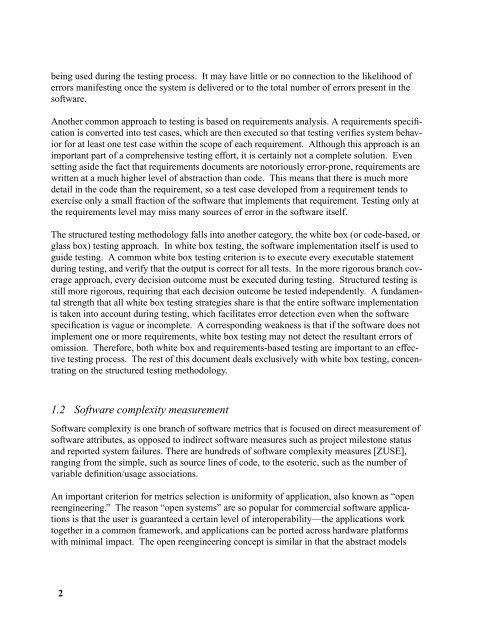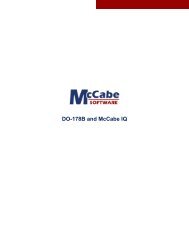Structured Testing - McCabe and Associates
Structured Testing - McCabe and Associates
Structured Testing - McCabe and Associates
Create successful ePaper yourself
Turn your PDF publications into a flip-book with our unique Google optimized e-Paper software.
eing used during the testing process. It may have little or no connection to the likelihood of<br />
errors manifesting once the system is delivered or to the total number of errors present in the<br />
software.<br />
Another common approach to testing is based on requirements analysis. A requirements specification<br />
is converted into test cases, which are then executed so that testing verifies system behavior<br />
for at least one test case within the scope of each requirement. Although this approach is an<br />
important part of a comprehensive testing effort, it is certainly not a complete solution. Even<br />
setting aside the fact that requirements documents are notoriously error-prone, requirements are<br />
written at a much higher level of abstraction than code. This means that there is much more<br />
detail in the code than the requirement, so a test case developed from a requirement tends to<br />
exercise only a small fraction of the software that implements that requirement. <strong>Testing</strong> only at<br />
the requirements level may miss many sources of error in the software itself.<br />
The structured testing methodology falls into another category, the white box (or code-based, or<br />
glass box) testing approach. In white box testing, the software implementation itself is used to<br />
guide testing. A common white box testing criterion is to execute every executable statement<br />
during testing, <strong>and</strong> verify that the output is correct for all tests. In the more rigorous branch coverage<br />
approach, every decision outcome must be executed during testing. <strong>Structured</strong> testing is<br />
still more rigorous, requiring that each decision outcome be tested independently. A fundamental<br />
strength that all white box testing strategies share is that the entire software implementation<br />
is taken into account during testing, which facilitates error detection even when the software<br />
specification is vague or incomplete. A corresponding weakness is that if the software does not<br />
implement one or more requirements, white box testing may not detect the resultant errors of<br />
omission. Therefore, both white box <strong>and</strong> requirements-based testing are important to an effective<br />
testing process. The rest of this document deals exclusively with white box testing, concentrating<br />
on the structured testing methodology.<br />
1.2 Software complexity measurement<br />
Software complexity is one branch of software metrics that is focused on direct measurement of<br />
software attributes, as opposed to indirect software measures such as project milestone status<br />
<strong>and</strong> reported system failures. There are hundreds of software complexity measures [ZUSE],<br />
ranging from the simple, such as source lines of code, to the esoteric, such as the number of<br />
variable definition/usage associations.<br />
An important criterion for metrics selection is uniformity of application, also known as “open<br />
reengineering.” The reason “open systems” are so popular for commercial software applications<br />
is that the user is guaranteed a certain level of interoperability—the applications work<br />
together in a common framework, <strong>and</strong> applications can be ported across hardware platforms<br />
with minimal impact. The open reengineering concept is similar in that the abstract models<br />
2



